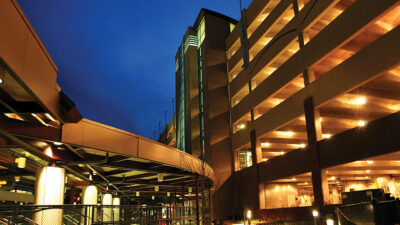A combination of active and passive fire protection systems is needed to address the factor of human behavior in the built environment

Learning Objectives
- Know that active and passive fire protection systems are often considered separate, but are starting to exist on a spectrum due to technological advances.
- Understand there are multiple ways to balance building systems to achieve an acceptable risk level.
- Learn about the efficacy of active and passive systems is dependent on human behavior, which may vary by region or between occupancies.
To construct and maintain a building that is safe for occupants and properly protects the building’s commodities, a combination of active and passive fire protection systems is needed to address the factor of human behavior in the built environment — it’s not one or the other. The fire protection industry is predominantly defined by sprinklers; however, sprinklers alone cannot produce the level of safety required for most buildings.
Instead, architects, engineers, building owners and code officials use a balance of passive and active fire protection systems to define what constitutes a building that meets expectations of the building code to preserve safety of the public and maintain property protection.
But what is the level of safety most dependent on? People. The constant maintenance of the building’s fire protection systems and whether people actually evacuate the building when told to do so determines if the life safety systems operate as intended.
Which fire protection option is better?
Passive and active fire protection systems are the means by which buildings throughout the world and their occupants are protected from accidental fires based on, in varying degrees, local jurisdiction requirements and the amount of trust that building occupants put into each system. The expectation of safety in modern buildings is very high, and active and passive systems form the foundation for people’s trust in the safety of buildings that they occupy.
From fire barriers to sprinklers, building owners, designers and building occupants often have strong opinions as to which types of systems are truly necessary and provide value. On one side is a recognition that buildings and their systems age and experience maintenance issues, which can cause systems to degrade or fail.
On the other side is a sense that building owners and designers are being asked to include too many systems to ensure occupant safety, creating complexity and resulting in unnecessary expense. There are varying degrees of understanding how active and passive systems work and their effectiveness and thus these systems will be defined for the specific use.
Passive fire protection systems
Passive fire protection systems are far less obvious to the untrained eye. Passive systems do not require a sequenced response to aid in the control of smoke and fire spread; instead, they are always in place and constantly working to reduce fire spread before a fire event starts and to assist in safe occupant evacuation during a fire event. The importance of maintaining these passive systems is critical in preventing a fire that starts in one portion of the building from spreading into adjacent portions of the building.
Systems include physical barriers in the building, such as firewalls, fire and smoke barriers, fire and smoke partitions and even nonrated wall assemblies, all of which help to stop or at least slow the spread of heat, smoke and toxic gases throughout the building. Passive fire protection systems also include fire doors (as well as roll-down doors and side-hinged swinging doors), firestopped penetrations and the means of egress system. Providing segregation and physical isolation between portions of a building via these passive systems successfully prevents fire spread and aids in occupant safety and property protection.
Fire protection system drawbacks
With the benefits of both active and passive systems also comes the issues of properly installing, maintaining and using each of these systems. For passive systems, it can be difficult to inspect and ensure that there are no issues for instance with a fire barrier. It is hard to confirm that every portion of the barrier remains intact and that there are no underlying weaknesses or connection points to adjacent horizontal or vertical assemblies, especially when a building remains in use. Maintaining fire barriers is a constant battle in places like corridor walls, since this is often the best location to run a new information technology cable or to create a new penetration for the electrical outlet required in a room adjacent to the corridor.
There are certain ways that facilities can help to prevent some of these carelessly placed penetrations. Fire barriers and partitions could be marked above a drop ceiling or in mechanical equipment rooms to signify the importance of the wall, including the rating to help show the importance of a firestopping system. Other facilities that have more regulation may require any contractors doing work to obtain an internal firestopping permit to better regulate the creation of penetrations.
Active systems also have some drawbacks to their usefulness. Building owners and architects constantly criticize sprinklers for their cost, difficulty of design installation and maintenance. Plus, once installed, sprinklers do not provide readily apparent benefits like a heating, ventilation and air conditioning system or electrical system; the benefit of sprinklers is apparent only in the rare event that a fire takes place.
However, when it comes to life safety and insurance premiums, providing sprinklers throughout a new building is logical. Sprinklers are also required in many building occupancies based on use or due to the height/area of the building to maintain a safe building. When sprinklers activate during a fire, it becomes clear that sprinklers are effective in preventing losses and further damage to the building.
Sprinklers are 87% effective overall at preserving the means of egress for evacuation and protecting property and typically only one sprinkler needs to activate to control a fire. They buy time to allow occupants to egress before the fire department fully extinguishes the fire.
Balancing fire protection options
Given that passive and active fire protection systems are each categorized by their trade-offs, is there a relationship between how likely the element is to fail and its complexity? Is there a design somewhere in the spectrum of passive and active systems that reduces overall failures while providing the highest level of safety of the two systems?
Figure 1 is a conceptual idea of a passive-active fire protection system. Although there is certainly some room for discussion, this infographic shows that systems must be used in conjunction with each other. As the spectrum moves from left to right, systems that require more moving parts and sensing equipment are inherently more subject to failure. These are considered active systems as opposed to passive systems.
The reliability of a passive system is higher, but is often kept in check by the active systems that also protect the building. For example, if a fire barrier (passive system) has too many penetrations that are not firestopped and allows the passage of heat and toxic gas from one compartment to another, the sprinkler system (active system) will activate and is able to contain the fire from spreading throughout the building.
As technology advances, fire protection systems are becoming more complex, which means that the potential for failures increase until we understand how the failures affect our system. However, once the failure modes are understood, the more complex systems become more reliable.
For example, a newer style of fire alarm system requires a significant amount of programming. Although the system is more complex, perhaps costlier and takes more time to commission, the more often newer systems are installed the more we learn about them. This leads to increased reliability over time. Therefore, are we getting to a place where we may start to rely more on active systems than passive systems?
Fire protection evolves
There is constant evolution in how the construction industry has balanced active and passive fire protection systems in building design. Unfortunate fire events that have caused loss of life and property damage have led to the industry to periodically rethink how buildings are constructed. This includes how code requirements shall be modified and how passive and active systems being installed in new construction shall be designed. Different passive and active systems are often explored and/or criticized by certain industries based on the necessity of the systems and the cost impacts during construction versus the effectiveness of those systems.
Events such as the Grenfell Tower fire in the United Kingdom have caused the construction industry to investigate the use of aluminum cladding in high-rise buildings and reconsider whether these materials should be used at all in buildings. Another example of materials used in passive systems currently under investigation is wood in tall buildings. The fire protection industry is currently doing extensive research on tall wood buildings to determine if using wood beams and columns, as opposed to steel, can provide a similar fire-resistance rating and structural support to buildings.
Along with this research, the 2021 edition of the International Building Code will provide three new construction types that will permit wood construction up to 18 stories tall. Although testing has confirmed that the charring on wood members can provide the same fire-resistance rating as structural steel columns, some local municipalities are hesitant to approve the design and construction of tall wood buildings within their jurisdiction.
Specifying sprinkler systems
The use of sprinkler systems has been debated for a long time due to the cost of installation compared to the success rate of sprinkler systems in providing protection. Issues with the cost of upkeep and accidental activation of sprinkler systems has led to a bad view of sprinkler systems. This has resulted in building owners and operators hesitant to agree to the use of such systems. Places like New York City have instituted retroactive sprinkler requirements on business buildings taller than 100 feet. This has a large cost impact to owners and developers, but increases the level of safety for occupants.
However, with significant push back from the real estate industry, high-rise residential buildings have not yet been subject to such retroactive requirements. Although sprinklers are widely used throughout the United States and generally believed to provide a high level of safety along with providing significant relief when it comes to building code requirements, there are countries like Japan, Poland and Russia where building codes do not put as much trust in sprinkler systems and allow other types of systems to protect occupants.
Systems international such as active smoke control, smoke compartments or exterior exit stairs with four-hour fire barriers are more likely to be found in these countries as opposed to sprinkler systems. In these cases, more emphasis is given to the protection of the means of egress than to require active fire protection systems.
Notification systems
Fire alarm systems have grown much more comprehensive and efficient in recent years. Systems are now addressable, which allows building management and the responding firefighting team to know exactly where an alarm condition is occurring. In addition, emergency responders can use fire service access elevators to quickly arrive in the location of the alarm condition.
Although notification systems have also advanced, the unfortunate human factor with fire alarm notification is that occupants are quick to dismiss fire alarm horns and strobes due to previous experiences in false activations of the fire alarm. In places like shopping malls, hotels or restaurants, occupants are less likely to evacuate the building during notification unless they have an additional cue such as seeing fire or smelling smoke. The introduction of live voice communication and mass notification systems have helped mitigate this issue. They provide better direction to the occupants such as “This is your fire safety director, we are investigating an alarm condition on the fourth floor” or “there is a fire condition on the sixth floor, please evacuate immediately.” This has significantly helped the effort of evacuation from buildings, but these systems are not required in all cases.
Smoke control
Smoke control systems have been used more often, especially in exit stairs in which pressurization is provided to ensure that smoke does not infiltrate the exit stair during an evacuation. Smoke control systems are also being used in atria to ensure that occupants are able to exit the building in a fire event before the smoke layer descends to a level where untenable conditions occur.
In some cases, smoke control is used to pressurize floor by floor where the fire floor or compartment would be negatively pressurized and the surrounding floors or compartments would be positively pressurized. This is done to ensure that any smoke from the originating fire compartment does not spread into surrounding compartments. This is an effective way to use smoke control systems upon the activation of an initiating device on the fire alarm system.
In addition to the active smoke control systems, there are many passive components such as elevator lobbies separation and smoke barriers that are constructed between residential units to ensure that a small kitchen fire does not spread to an adjacent neighbor.
Understanding fire protection systems
In general, even with all passive and active systems working as expected, there is always the human behavior aspect that is unpredictable, which changes how each system should be used. As previously mentioned, occupants of a building often do not respond to a fire emergency unless they have multiple cues convincing them that there is a real threat of fire. Depending on the occupancy type, occupants may be given instructions by trained professionals, such as in a hospital.
However, without direct instructions, occupants may not be able to recognize hazards associated with small changes or may not even be able to see such small changes due to their lack of familiarity with fire protection systems. Examples of such hazards include small penetrations that are located above a drop ceiling that are no longer firestopped due to ongoing maintenance or installation of new IT cables or a sprinkler system where water is turned off due to an ongoing construction project.
The other major issue with occupant’s understanding of active and passive fire protection systems is the fire severity and how it is often underestimated. In many cases where fires start, occupants have just a few minutes to evacuate from the immediate vicinity, especially given the material changes in recent years such as the influx of plastics in furniture and increased use of decorative materials.
Finally, how do we address the time sensitivity of routine testing and maintenance of a system to ensure all components are in working order? Certainly, having a building closed or evacuated because a sprinkler system is undergoing testing or maintenance is not appropriate, but how long should a sprinkler system in an occupied building be allowed to be inoperable?
The industry looks to standards like NFPA 25: Standard for the Inspection, Testing and Maintenance of Water-Based Fire Protection Systems to determine how frequently systems need to be inspected and tested. Without the upkeep of these systems, what would be the purpose of having them installed?
In summary, designers, owners and maintenance personnel need to lead by example to preserve the safety of a building. People are needed to design systems properly, maintain these systems and occupants should be properly informed to evacuate upon the initiation of any active fire protection system. During the design, construction or renovation, if it appears that a system is not working as designed, that system needs to be repaired. Without each system working as it is intended to, it is likely that the entire fire protection system will not work together to preserve property and life. After all, what is the purpose of designing fire protection systems and putting them into service, if the systems don’t work in the end?



